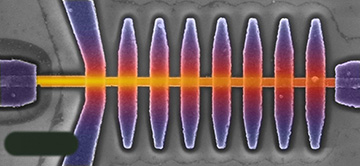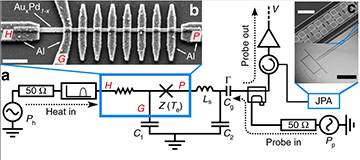
False-color image of nanoscale bolometer designed by a team based at Aalto University, Finland. The dark bar at the lower left is the size of a Ralstonia mannitolilytica bacterium (approximately 1.3 μm in length). [Image: Roope Kokkoniemi/Aalto University]
Bolometers—sensors that gauge the power of incident electromagnetic radiation by measuring its heating effects—have been workhorses in astronomical sensing, consumer devices and security applications such as thermally sensitive cameras. As with all sensors, however, to drive new applications, engineers are continually on the lookout for ways to make bolometers smaller, better, and faster.
Researchers led by a team at Aalto University, Finland, have now unveiled a nanoscale bolometer that they claim is ten times faster, with a noise floor ten times lower, than other low-noise bolometers, and with a footprint less than 10 μm across (Commun. Phys., doi: 10.1038/s42005-019-0225-6). The device, the group reports, is capable of resolving calorimetric energy changes down to a scale of 0.3 zeptojoules (10–21 J, or sextillionths of a joule), with a thermal time constant of a mere 30 μs. And, with a bit more engineering to make it even faster, the researchers believe it could find use in cutting-edge applications such as detecting single terahertz photons and reading out the value of quantum bits (qubits) in superconducting quantum computers.
A matter of temperature
Bolometers work because of the temperature dependence of electrical resistance in some materials. As electromagnetic radiation hits the target material, the incident power infinitesimally boosts the material temperature; this in turn changes the material’s resistance, which can be read out and related back to the power of the radiation. The speed at which this happens hinges on the bolometer’s thermal time constant—the time it takes the instrument to heat up enough to give a reliable reading. That time constant, in turn, depends on the sensor material’s heat capacity and the geometry and design of the detector.
To create a better model, the Finland-based team—led Mikko Möttönen of Aalto and the VTT Technical Research Centre of Finland, with other scientists from Aalto, VTT, the U.S. National Institute of Standards and the California Institute of Technology—began by thinking small. Building on a design published three years ago by Möttönen’s group, the team laid down a gold–palladium wire only ten microns long, 200 nm in width and tens of nanometers thick across an array of superconducting aluminum islands oriented perpendicular to the nanowire. The first of the superconductor/normal-metal/superconductor junctions creates the resistive load for detecting the radiation, and the other junctions form an inductor–capacitor resonator for readout of the signal.
Photomicrographs and schematic of the device. H, P and G are electrical leads for signal acquisition and readout; JPA is Josephson parametric amplifier. [Image: R. Kokkoniemi et al., Commun. Phys., doi: 10.1038/s42005-019-0225-6 (2019); CC–BY 4.0] [Enlarge image]
Size matters
Making the bolometer so small, the paper’s lead author, Roope Kokkoniemi of Aalto University, explained, was one key to increasing its sensitivity. “A small radiation detector has a low heat capacity,” he said in a press release accompanying the research, “so weak radiation provides a stronger signal.” The team also upped the ante on the previous device by adding a nanoscale Josephson parametric amplifier (JPA) to the readout circuit, which can amp up the power of the readout and potentially increase the resolvable signal.
In tests of the bolometer with the JPA turned off, the researchers found that it could measure a noise-equivalent power (NEP) of 50 zW/Hz½, with a time constant of 0.6 ms—and that they could drive the time constant to below 100 μs by letting the resolvable NEP slip to 80 zW/Hz½. With the JPA turned on, the instrument was able to resolve an NEP of 60 zW/Hz½ in 30 μs. Both numbers, according to the team, are at least an order of magnitude better than for previously reported bolometers. And they imply the ability for the bolometer to pick up calorimetric energy changes of as little as 0.3 zJ in 30 μs.
Quantum Applications
The researchers see a variety of potential applications for the device as they continue to improve its stability and resolution. One suggestion, for example, is that it might be used on spacecraft for ultrasensitive measurements of the cosmic microwave background (CMB) from the Big Bang. It could also ultimately serve as the basis for sensitive terahertz antennas or single-photon counters, widely sought for new detectors in astronomy and elsewhere.
The application sphere that Möttönen and his team are particularly eyeing, however, is emerging quantum information technology. The new bolometer, for example, might be used to keep tabs on radiation levels in the ultra-cold cryostats housing superconducting quantum computers, to highlight the need for better shielding of those sensitive instruments.
In the longer term, there’s even the possibility, according to Möttönen, that the new bolometer could be used as a readout device for qubits from superconducting quantum computers. For this purpose, however, the team will need to hammer down the response time even more. “To read quantum information in superconducting quantum computers several times in a row without it degrading in between,” he said, “the bolometer would have to be about a hundred times faster.”

